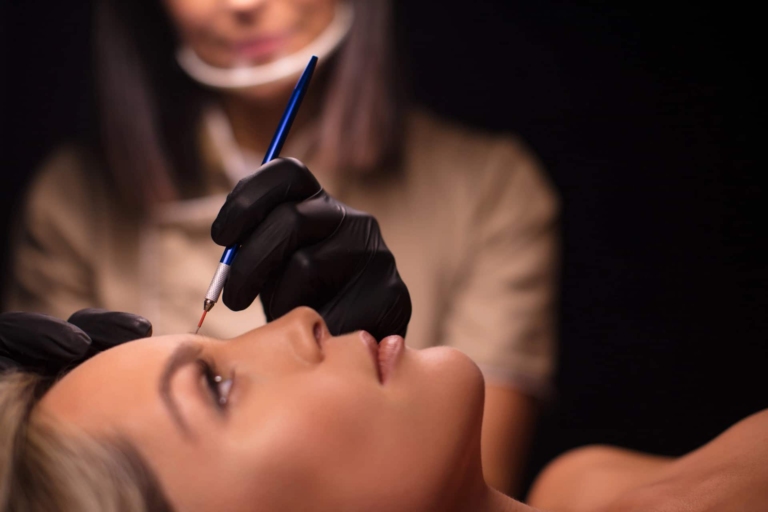Myla Bella hair glossary
Catagen
One of the three phases of hair growth.
Catagen is the phase of slowing and attenuating hair growth until it stops completely and falls out.
The follicle shrinks more and more, and the hair approaches the level of the epidermis, preparing to rest.
This phase lasts around three weeks.
Katam
Dyeing herb, Buxus dioica.
Katam is an herb that produces dark colors similar to indigo.
The difference is that it has a violet glow, warmer than indigo.
Malic acid
An acidifying additive for herbs.
pH 3-3.75.
Found naturally in apples, but also in many other fruits: cherries, apricots, blackberries, grapes.
Contains large quantities in rhubarb, especially the root.
Malic acid can be used to acidify henna, but also to lighten hair.
Be very careful when bleaching, and test first on a small area of skin, adapting the concentration to the sensitivity of your hair and scalp.
It’s best to avoid the scalp or leave the lightening mask on for no longer than 5-10 minutes.
Citric acid
An acidifying additive for herbs, it also works well as a chelating mask additive.
One of the cheapest and most versatile acidifiers.
Stratification
A protein treatment performed on the hair using gelatin or jelly in the following ratio 1 tablespoon of jelly or gelatin to 1 tablespoon of warm water.
After mixing, add 2 tablespoons of conditioner.
For medium-length hair, use 2 to 3 tablespoons of jelly, for long hair up to 5 tablespoons.
The concoction is applied to washed and drained hair for 30 minutes under a cap.
After this time, rinse with water, dry your hair and enjoy the effect of detached hair.
Lawson
A pigment, 2-hydroxy-1,4-naphthoquinone.
Found in the leaves of the lavson plant, it is responsible for henna’s coloring properties.
Lawson likes an acidic environment.
The CGM Curly Girl Method
Lorraine Massey’s CGM method of curly hair care, which excludes shampoos, silicones, drying alcohols and sticky substances such as kerosene or wax.
Under this method, hair is washed only with conditioner, and shampoo is used only to “reset” the hair, the so-called final wash.
Spiral method
A method of applying henna and other herbs in which we start at the crown of the head and then form a spiral with fine strands wrapped around the beginning of the spiral.
This method enables henna to be applied with precision to both the roots and the length of the hair.
Honeying
A treatment in which we provide the hair with humectants using honey.
The honey is mixed with a simple emollient conditioner and applied to dry or damp hair for 30 minutes under a film.
Rinse.
Hair is soft and moisturized.
Misking
A washing method that involves applying conditioner to wet hair, combing it through and squeezing excess product onto a bowl.
The hair is then soaked in a bowl and the product reinfused.
This operation is repeated several times, then rinsed with water.
Brushing is an excellent way to emulsify the oil.
Freezing
A method of storing prepared henna paste.
This is how you store henna and cassia, not indigo.
Frozen henna can color more intensely.
Freezing henna in cubes is a great way to stock up on herbs for quick glosses, to mask your roots, or simply to save time on your next henna treatment.
Remember that indigo, and any mixture containing this plant, must be stored in powder form and prepared immediately before application.
Superstructure
Substances accumulated on the hair surface, whether desirable or undesirable.
Undesirable build-ups include silicones, waxes, polyquats and excessive proteins.
Minerals from hard water also accumulate.
All can be removed by washing with a powerful shampoo and/or chelating agent.
We also speak of overbuilding in the case of henna.
Henna and cassia cover the hair each time with a new layer of pigment.
With henna, the color becomes darker and darker, moving towards chestnut, and with cassia, it becomes more golden/honey/yellow.
Naphthoquinones
Chemical compounds derived from naphthalene, which often have a coloring effect.
Low-porosity hair
Low-porosity hair (see porosity).
This is the term used to describe hair that is smooth, slippery and resistant to styling.
No-poo
No shampoo.
Shine-free washing can be done with herbs, soap nuts and flour.
OMO
A hair-washing method designed to protect hair from detergents and/or achieve better conditioning.
On wet hair, first O apply any conditioner to the entire length of the hair, then M shampoo the scalp, rinse and finally O apply conditioner again and rinse.
PEH
Short for proteins, emollients and humectants.
Plopping
A method for styling curly hair.
It involves placing curly hair after styling on a towel so that the hair rests loosely on it, then tying the towel at the back.
It’s important that curls retain their natural spring shape.
It’s best to use a cotton T-shirt for this purpose.
Also read: the encyclopedia of hair
Porosity
Porosity determines the degree of deviation of the hair cuticle.
Hair porosity is linked to its ability to absorb and “coat” various hair care ingredients, such as oils or proteins.
We classify hair into rough, medium and rough types.
Assessing your hair’s porosity is useful when choosing oils and conditioners.
To assess porosity, it’s best to do a test.
Praying hands method
Method of applying styling aids to wet curly hair.
When applying styling aids, spread them between the palms of your hands and fold them like a prayer.
Then press up and down, flattening the strands.
Once you’ve applied the styling product packets using this method, you can also crimp the hair.
This method makes it easier to create curls and bigger curls.
Protein
The basic building blocks of hair.
The purpose of proteins in hair cosmetics is to fill gaps in the hair (those with small molecules) or to form a protective layer around them – the property of proteins with larger molecules.
Keratin, silk and amino acids are examples of proteins.
Drought
A phenomenon that occurs after the herbs have been rinsed and the hair has dried, manifesting itself as dry, greasy and dull hair.
The cause may be insufficient rinsing of the herbs il, is then recommended to use the siren method, or adding too strong an acid or too much acid.
Lemon is renowned for its dryness and is often chosen by beginners.
Dryness may occasionally appear as an individual hair reaction, even every time.
This effect should pass after the first wash and an emollient hair treatment.
Bleaching
The process leading to lighter hair color.
It can be done with herbs such as chamomile, rhubarb, honey, malic acid or a traditional bleaching agent.
All herbs can be lightened, except indigo.
In the case of excessive henna lightening, masks and lightening rinses work well.
Rypacz
Term for a shampoo that contains “strong” (cleaning) detergents and no film-forming substances.
Strong detergents are called SLeS Sodium Lauryl Sulfate, SLS Sodium Lauryl Sulfate, MLS Magnesium Laureth Sulfate, ALS Ammonium Laureth Sulfate, SCS Sodium Coco-sulfate, Sodium C14-16 Olefin Sulfonate.
Senese: Senna
Cassia angustifolia, a close cousin of cassia.
Senes is distinguished from cassia by its more pronounced yellow color.
It is generally less well ground, as it is not as common as cassia and is ground for food purposes.
Senesce is strongly colored thanks to its high chrysophanol content.
As for the preparation, it is acidified and set aside, like cassia, for 20 hours.
After this time, it is applied to chelated hair that has been washed with a strong shampoo.
Salt
An additive for herbs.
It works best with indigo and its blends as a fixative.
Salt is one of the few color fixatives that is safe to use on the skin.
In most cases, color fixatives used in dyes, for example, can be highly irritating to the scalp.
Styler
A product designed to set the curl.
The styler can be a gel, mousse or cream.
It can also be used to straighten hair.
Telogen
One of the three phases of hair growth.
Telogen is the hair follicle’s resting phase.
Old hair falls out or is pushed out by new hair in the anagen phase.
This phase can last from two to four months.
The test
A test to show the approximate effects of henna or coloring on the hair.
This test can be used with any coloring substance.
To perform the test, we need a tusk, which is a hair collected from a brush.
We recommend collecting the hair for at least a week, washing it with shampoo immediately after collection, drying it and storing it in a paper bag.
Once you’ve collected enough, you can test the color or interaction with your current color, or you can cut the strands into pieces and test with, for example, different acidifiers or additives.
The three hair sections
Divide your hair into three sections: scalp, length and ends.
Each of these sections needs different cosmetics and ingredients to work properly.
Loop type
A classification that defines the level of frizz in hair.
The most popular classification was created by Andre Walker, in which twist is defined by the numbers 1 to 4 – A to C, which determine the compactness of the twist within the same type.
Dyer’s Urzet
An additive, a coloring herb, Isatis tinctorial.
Urzet dye darkens hair like indigo, but has weaker coloring properties and does not give a blue sheen.
It can be used to obtain very natural, dark browns when mixed with henna.
Oxidation
The process by which henna color acquires its final appearance is darkening.
Therefore, remember to wait 72 hours without any other products after the henna treatment so that this process can take place and bring out the full effect of the color.
If you think it will be too dark, you can stop the oxidation process by washing your hair.
The color may then be less long-lasting.
You can observe oxidation on the prepared mixture from a few minutes to a few hours.
For oxidation to begin, the henna is set aside.
The most important information about oxidation is that you will see the final color after henna treatment after about 3 days.
Wet cleaning
Also known as “wet plopping”.
This involves placing your still damp hair on top of your head after styling, so that your hair spontaneously springs back into place, then placing a foil cap over it.
Leave on for around 10 minutes, then remove the cap and start drying.
The benefits of wet plopping are better definition and less frizz.
Hair styling
Generic term for a one-off treatment, another for a “hair spa” or simple wash.
Originally, hairpieces were wrapped in aluminum foil and wrapped around the hair.
The term is now used to describe conscious care of the hair and scalp.
Very porous hair
Very porous hair. The type of hair whose cuticle structure resembles an open cone or Christmas tree, with its cuticles clearly detached.
This is the type of hair whose cuticles resemble an open cone or Christmas tree, with the scales clearly detached from the cuticles.
Acidification
Addition of substances with an acidic pH to herbs, usually henna or cassia, to extract the pigment.
Different acidifiers have different pH levels and properties to achieve the desired color effect.
With any acidifier, be careful not to add too much!
You risk drying out your hair.
“One of my biggest dreams is that my company will be able to change the course of one family’s life, one child at a time by giving back to the community.”







